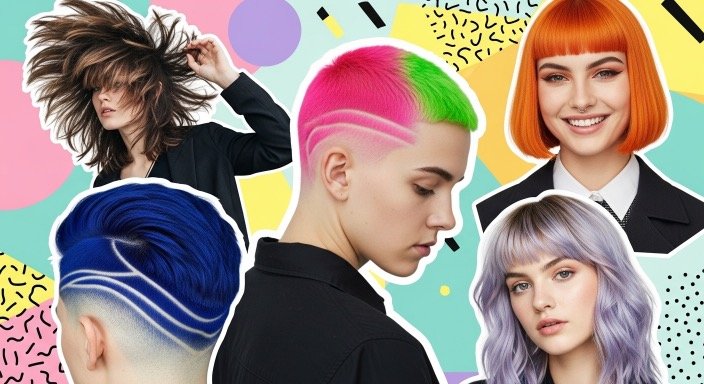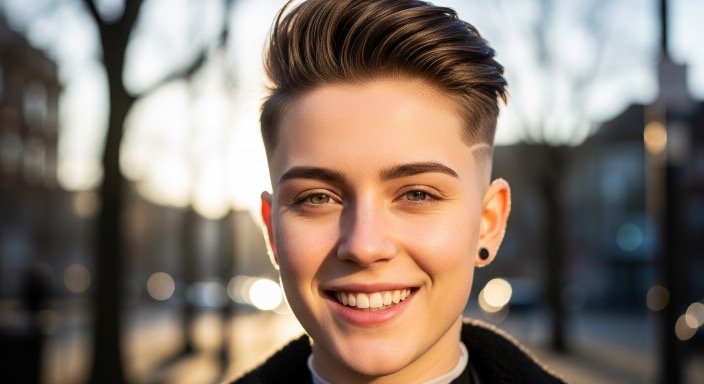Gen Z haircuts
Ever notice how a new haircut can instantly change how you feel about yourself? For Gen Z, haircuts aren’t just style statements — they’re small acts of rebellion, renewal, and even healing.
This generation has made it clear: self-expression and mental health go hand-in-hand. A bold fringe, a buzzcut, or even pastel streaks can symbolize control, confidence, and emotional restart.
According to Sage Journals about self-expression, researchers found that changing appearance — whether — often reflects deeper psychological shifts. For many Gen Zers, a haircut represents emotional release and self-redefinition.
At AllMentalIllness.com, we believe self-care looks different for everyone. For some, it’s journaling or therapy; for others, it starts with scissors and a mirror.
Why Gen Z Sees Hair as Emotional Therapy
For older generations, changing hair might have been about keeping up with trends. But for Gen Z, it’s something much deeper.
Social media platforms like TikTok and Instagram are filled with transformation videos tagged #breakupcut or #healinghair — where people chop off inches as symbols of growth after anxiety, burnout, or heartbreak.
According to Science Direct, creative self-expression boosts mental wellness by giving people a sense of agency and emotional release.
Cutting or coloring hair is a safe, visible way to mark a new chapter — similar to journaling or starting therapy. It helps people say: “I’m ready for change.”
Related Read: Positive Affirmations for Self Love – Reprogram Your Mind shows how self-talk, like a new haircut, can rewire confidence from the inside out.
The Psychology Behind Changing Your Look
Hair as Identity
Hair is one of the most visible forms of self-expression. It shapes how we see ourselves and how others perceive us. When people feel stuck or invisible, changing hair can become a symbolic act of reclaiming identity.
Harvard Health reports that external self-care actions — even small ones — can influence mood regulation. A haircut might not cure depression, but it can spark motivation by providing a sense of renewal.
The Science of Control
Mental health struggles often involve feeling powerless. Altering appearance offers an instant, tangible sense of control. It’s an act of choice in a world that sometimes feels uncontrollable.
This idea echoes research from the National Institute of Mental Health, which shows that positive behavioral actions can reduce symptoms of anxiety and low self-esteem by reinforcing self-efficacy — the belief in one’s ability to make change.
For Gen Z, the mirror becomes a metaphor: “If I can change my hair, maybe I can change my life.”
Top Gen Z Haircut Trends That Reflect Emotional Growth
Gen Z Haircuts

Gen Z Haircuts
Each style tells a mental health story. These aren’t just aesthetics — they’re emotional statements.
1. The Buzzcut: Reclaiming Power
Many people shave their heads after intense emotional periods — like heartbreak or burnout — as a sign of liberation. The buzzcut symbolizes renewal and freedom from expectation.
As one TikTok user shared in a viral post: “I shaved my head because I needed to feel something I could control.”
2. The Shag or Wolf Cut: Embracing Imperfection
Messy, layered, and natural — the wolf cut became an anthem for authenticity. It rejects the idea of “perfect” and embraces “real.”
For many with anxiety or body-image struggles, it reflects acceptance: you don’t have to fit a mold to feel beautiful.
3. The Bold Color Transformation
Gen Z uses color as emotional language — pink for softness, blue for calm, green for rebirth.
Coloring hair can serve as color therapy, a creative outlet that mirrors emotional states.
According to Insights Psychology, bright hues can influence mood and create psychological balance by stimulating positive associations.
4. Curtain Bangs and Fringe Freedom
The act of cutting bangs often marks transformation — sometimes impulsive, sometimes healing. It’s about control, visibility, and redefining how you frame your face (and your life).
For more on creative healing through art and symbolism, explore Beautiful Mental Health Tattoos to Inspire Healing.
Haircuts, Self-Esteem, and the Dopamine Effect
There’s science behind that post-salon glow.
Changing appearance triggers dopamine — the brain’s “feel-good” chemical — which can temporarily boost mood.
But beyond the chemistry, it’s the ritual that matters. The smell of shampoo, the sound of scissors, and the feeling of transformation all create mindfulness in motion.
It’s an act of self-care disguised as vanity — and for many, it’s deeply healing.
A study in the Journal of Behavioral Therapy and Experimental Psychiatry found that engaging in physical acts of self-renewal (like hair changes) can enhance feelings of emotional control and well-being.
Social Media and the “Hair Heals” Movement
The hashtag #HairHeals now carries millions of views. From breakup cuts to anxiety trims, people share their transformations publicly — not for validation, but to say “You’re not alone.”
Social platforms, when used mindfully, have become digital therapy spaces where Gen Z normalizes mental health conversations.
The NIH acknowledges that online self-expression can reduce isolation and stigma when paired with offline support.
Still, it’s essential to balance digital healing with real-life coping — therapy, journaling, and mindful routines.
Need guidance on starting therapy? Read How to Talk to a Therapist for the First Time for a step-by-step comfort guide.
Haircuts as a Symbol of Healing and Change
Gen Z Haircuts

Gen Z Haircuts
Many Gen Zers describe haircut moments as “spiritual resets.”
When life feels chaotic, the body remembers the ritual of transformation — scissors cutting away the weight of yesterday.
This symbolism runs deep in human psychology. From ancient cultures to modern trends, hair has always represented renewal — a shedding of the old self.
Tides Mental Health documents that across cultures, cutting hair often marks transitions like grief, freedom, or growth — mirroring emotional milestones.
The Line Between Healing and Escapism
It’s worth noting that while hair transformations can help emotional release, they’re not substitutes for therapy.
If you notice repeated impulsive changes or distress driving the behavior, that’s a signal to look deeper.
Healthy transformation comes from intention, not avoidance.
Pairing creative self-expression with mental health support — journaling, therapy, or mindfulness — helps turn a haircut into genuine growth.
How to Use Your Next Haircut as a Confidence Tool
Here’s how to make your next salon trip part of your healing routine:
- Set an Intention – Ask yourself what emotional shift you want this haircut to represent.
- Pick Symbolism Over Trend – Choose a look that reflects you, not what’s viral.
- Practice Mindfulness – Notice how it feels to let go. Focus on the sensory experience.
- Affirm Your Change – Use affirmations from Positive Affirmations for Self Love while looking in the mirror post-cut.
- Document Your Growth – Take photos, journal, or share your story online to inspire others.
Transformation becomes powerful when it’s done with self-love instead of self-criticism.
Gen Z Haircuts
Final Thoughts: When Style Becomes Self Care
A haircut won’t erase anxiety or trauma — but it can symbolize something far bigger: your decision to start again.
Gen Z has redefined what beauty means. It’s no longer about perfection; it’s about authenticity. When they change their hair, they’re not chasing approval — they’re claiming identity.
So, whether it’s a buzzcut born from burnout or pastel streaks painted in joy, remember this: every strand you cut can carry away something that no longer serves you.
Healing begins in small acts — and sometimes, those acts start in a salon chair.
At AllMentalIllness.com, we celebrate all forms of creative healing. Continue exploring emotional growth through:
- Beautiful Mental Health Tattoos to Inspire Healing
- Positive Affirmations for Self Love – Reprogram Your Mind
- How to Talk to a Therapist for the First Time
Our Authority Sources
- Sage Journals
- Harvard Health – Understanding Depression
- National Institute of Mental Health – Depression
- Insights Psychology
- NIH – online self-expression
- Tides Mental Health
